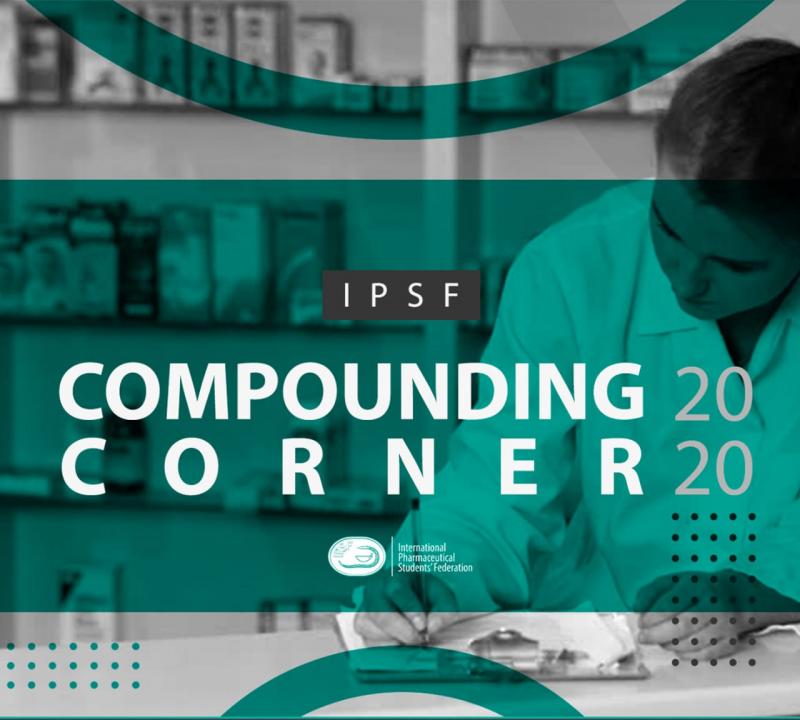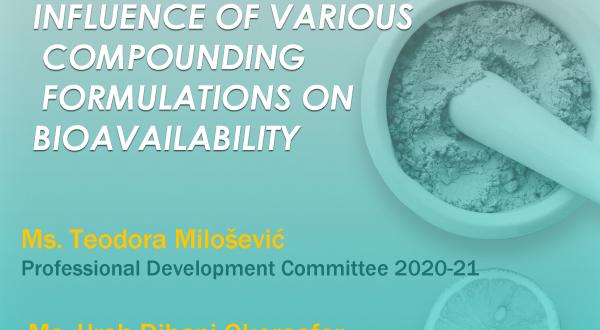
Compounding practices: before and now
By: Ureh Dibani Okoroafor
Compounding Event coordinator 2020-21
and
Baron Christopher, Sania Delvita and Victoria Ezeudensi
Professional Development Committee 2020-21
Pharmaceutical compounding can be said to be the art and science of creating customized medication for patients. This practice dates back to the origin of pharmacy, and has over the years evolved to maintain relevance in our modern world.
Patient compliance
In the past, people compounded medicines without putting patient compliance into consideration, but now preparations are compounded in ways that encourage patient compliance and also ensure that personalized medications are available for patients who need alternative strengths, dosage forms and flavours. Compounding can also be used to alter the formulation of drugs in a bid to enhance tolerability and minimize untoward effects such as allergies or sensitivities. For example, patients who are chromophobic (i.e. scared of some colours), or have dislike for certain drug formulation flavours can have their displeasure eased through pharmaceutical compounding processes. Through compounding, the flavour of a drug solution can easily be changed from one form to another, for instance, from banana to strawberry flavour. Oftentimes, a community or a hospital pharmacist compounds drugs for patients that cannot tolerate certain prescribed medication(s) by the physician. For example, patients that are allergic to certain drug excipients, elderly patients or children that can’t swallow pills and need medicines in a liquid form (but the medicine comes only in solid dosage form).
These innovations have really differentiated the past and present compounding practices. In the past, leaves were crushed, triturated and given to the patient, without regard of it's taste and/or smell, but in this modern time, unpleasant tastes and smells can easily be masked, so as to increase patient compliance.
Equipment
The equipment for compounding before the modern era are slightly different from the equipment that are being used today. As noted by Mariott and his co-workers in 2010, the equipment for compounding laboratories were initially not designed specifically for pharmaceutical purposes but for other domestic or professional purposes such as cooking, farming, milling, brewing and distilling. But later on, some of the basic laboratory equipment for pharmaceutical purposes were developed and refined . An example of evolution in compounding equipment is seen in equipment used for weighing. Before the 15th century, single-pan steelyard beam balances were used to weigh pharmaceutical components. In the 15th century however, a double-pan steelyard beam balance was introduced. In a bid to support the scale reading, troy weight system was introduced which was subsequently replaced by the avoirdupois system due to non-uniformity of weights common in troy system.
The compounding equipment today are more digitalised and easier to handle. Avoirdupois systems are not in use anymore. Methods such as the use of electronic analytical balance -that only needs to be plugged into an electrical socket- are now being adopted.
Prescription drugs and compounding
During the 1930s and 40s, almost all prescriptions were being compounded, but with the advent of mass production of medicines during the 1950s and 60s, extemporaneous compounding of drugs declined as pharmacists now have several dosage forms of many drugs. This practice however has a major drawback; the “one size fits all” approach to medication results in some of the drugs-related needs of some patients to remain unmet. In the 20th century, mass production of drugs started, and was welcomed by many, consequently making compounding to be the secondary function of pharmacy. Data shows that from the 1920s through 1971, the number of prescriptions filled in American pharmacies requiring the knowledge of compounding declined from 80% to 1% or less. This happened due to the fact that pharmacists do not have to compound prescribed drugs from raw materials anymore.
However, some say that these numbers have reversed and the number of prescription drugs that need to be compounded has risen. Loyd V. Allen, editor-in-chief of the International Journal of Pharmaceutical Compounding, estimates that at least 10% of prescriptions are compounded. The rise in this number is affected by the rising needs of patient-specific dosings, such as for geriatric patients, paediatrics, preference to certain flavours etc., and to provide necessary medications when commercially manufactured products are unavailable."
Regulation
One of the major things that differentiate the practice of pharmaceutical compounding in time past and today is the presence of regulations. A long time ago, regulatory bodies were uncommon around the world and there was no such thing as nationwide regulation or local regulation. In contrast with the practice today, regulatory bodies exist for pharmacy practice and compounding. One of their jobs is to produce regulation, uniform standards, and guidelines to guarantee that only the highest quality products are prepared for the patients and to ensure patient health and safety. Regulatory bodies are in charge of creating regulations and making existing regulations striken so as to ensure the safety of patients.
One real case happened in Australia in 1990 in which the Therapeutic Goods Regulations of 1990 exempted compounded products from registration by the TGA (Therapeutic Goods Administration, Australia FDA) on the condition that they “are dispensed, or extemporaneously compounded, for a particular person” and they are prepared in a pharmacy “for supply (other than by wholesale) on or from those premises”. Due to this exemption, compounded medicines were not subjected to evaluation by the TGA. Although there have been few confirmed incidents of harm from compounded products, the potential is great with the absence of quality control measures, especially when it comes to sterile parenteral products. In response to this, The Pharmaceutical Society of Australia since then has created Professional Practice Guidelines for Compounding as well as a specific compounding chapter in the Australian Pharmaceutical Formulary and Handbook. Moreover, TGA is currently working with pharmacy professional bodies, regulators, state health departments and other stakeholders to review and improve compounding standards in Australia.
Creating unavailable or discontinued medication
Compounding is now committed to creating unavailable and discontinued medications so as to meet the therapeutic needs of patients. There are times that companies may stop manufacturing a drug product due to low profit or due to commercial shortage of some raw materials. Today, through compounding, there are more these gaps are filled and patients' drugs-related needs met.
Personalizing compounding
Compounding has further evolved into more innovative practices, such as customised dosages, alternative drug delivery systems and production of allergen-free formulations. Compounding can now be used to tailor (i.e. make medical doses and strengths that work with each patient's specific requirements such as body surface area and age. Formulations can be adapted to meet unique medical needs such as preparing intravenous preparations, sustained release thyroid medications or alternative delivery systems including sprays, transdermal applications, oral capsules, topical creams, ointments, gels and powders. Compounding can also be used to prepare formulations that are kosher or free from lactose, gluten, soy, diary, fragrances and dyes, depending on the patient's allergens, sensitivities or lifestyle preferences.
History of compounding
Compounding has evolved over the years. In ancient times, physicians were the ones responsible to do both prescribing and compounding of a patient’s medication but in the 19th century, a clear distinction between the role of a physician and that of a pharmacist was developed. And then in the 20th century, the compounding pharmacies diminished due to mass drug monitoring. However, that is not the case today.
With just a few of the changes discussed, we can see that there has really been a tremendous improvement regarding pharmaceutical compounding practices in our society today. A bonus point for this article is the names by which people that compound are called; apothecaries and pharmacists in olden days and present time respectively. It is however noteworthy to know that the word apothecary is still being used to refer to a pharmacist.
References
1. Cowen DL, Helfand WH (1990). Pharmacy: An Illustrated History. New York, NY: Harry N Abrams Inc.
2. Feldschuh M (2008). Compounding in community pharmacy. Australian Prescriber. 31. 30-31. Doi: https://10.18773/austprescr.2008.016
3. Matheny C, Martin CM (2010). Compounding pharmacy: old methods finding a new niche. Consult Pharm. 25(6):357-63. doi: 10.4140/TCP.n.2010.357
4. Marriott JF, Wilson KA, Langley CA, Belcher D (2010). Pharmaceutical Compounding
and Dispensing. Pharmaceutical Press.
5. Medisca (2020). History and Evolution of Compounding. Available at https://www.medisca.com.au/compounding/history-and-evolution
6. Petersen C (2020). The Evolution of Compounding. Women’s International Pharmacy. Available at
https://www.womensinternational.com/blog/evolution-of-compounding/
7. Siamidi A, Pippa N, Demetzos C (2017). Pharmaceutical compounding: Recent advances, lessons learned and future perspectives. Glob Drugs Therap 2: DOI: https://10.15761/GDT.1000115



